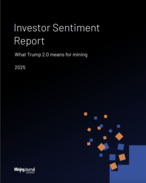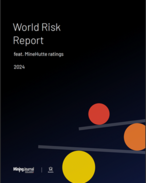Although the IPO was a success and the Gawler Craton, where the company had the bulk of its ground, was sexy enough to send most mining punters into a frenzy, it was a love affair that didn’t last.
The problems had nothing to do with Craton itself. It was just another casualty of the Busang gold fraud in Indonesia. By March 1997 the full waft of the Bre-X Minerals pong was hitting Australia. This coupled with a fall in the gold price and native title concerns were enough to march Craton’s share price south and wipe out much of the gains made early in its fledgling corporate life.
| |
Basin's managing director, Dr Brad Farrell: "I guess ... we're a bit unique in that we continue to explore vigorously. We've put 200,000m of drill holes down since we've been in the [Murray] Basin; effectivelly we've had two rigs running constantly for the past two years."
|
Putting his nose to the wind, Basin Minerals’ managing director, Dr Brad Farrell, decided it was time for some drastic action. By late April, Farrell, who has an extensive history in the mineral sands game, was steering Basin Minerals away from gold and into the Murray Basin at a great rate of knots.
Although the immense strandline potential of Murray Basin was still very much unknown back then, there was method to the madness. The biggest holder of clues was CRA’s mammoth fine-grained WIM 150 deposit, which had been discovered some 15 years earlier.
WIM 150 never got off the ground due to metallurgical and marketing problems arising from its fine-grained nature (median grain size 50 microns), however, its presence was considered by Basin Minerals to be indicative of a massive mineralised province in which large beach-hosted coarse grained (median grain size 150 microns) strandlines should also be present.
Basin Minerals reasoned that southerly drift within the Murray Basin would have caused huge quantities of heavy minerals to be carried south and accumulate against the rugged palaeo-coastline of the Grampians region in Victoria, and that the Grampians formed a major headland at the opening of the Murray Basin into the Southern Ocean. Thus the key ingredients of maximum energy, interaction with the coastline and entrapment of heavy minerals would have occurred in the headlands and embayments of the Grampians.
The results that have come from this reasoning have been stunning. In the past 12 months the company has drilled up strandline deposits at Acapulco, Bondi, Bondi East, Chetwynd and Echo. Its total Douglas project area is the biggest coarse-grained resource in the Murray Basin with more than 12.7 million tonnes of heavy mineral sands containing good grades of rutile, zircon and ilmenite being identified.
Until now Basin Minerals has kept its mineral sands assets in a similar named subsidiary company called Basin Minerals Holdings. However, because “the baby got too big for the bathtub” the company voted to change its name to that of its unlisted subsidiary, which has become known as an aggressive Murray Basin mineral sands explorer.
For a small exploration company Basin Minerals is in good shape — the company has $3 million in the bank and has just 40 million shares on issue with directors and management speaking for about 40% of the stock. The company’s cash burn rate is estimated at about $150,000 per month
The topped-up cash kitty will be invaluable in the next 12 months as the company moves to shore up the most advanced of its strandline deposits. These four — Bondi, Bondi East, Echo and Acapulco — when subject to further infill drilling are expected to have a confirmed measured resource containing greater than 13Mt of valuable heavy mineral.
Bulk sampling work to test the material’s metallurgy has been completed with very encouraging results, including high values from specified ilmenite, rutile and zircon samples.























